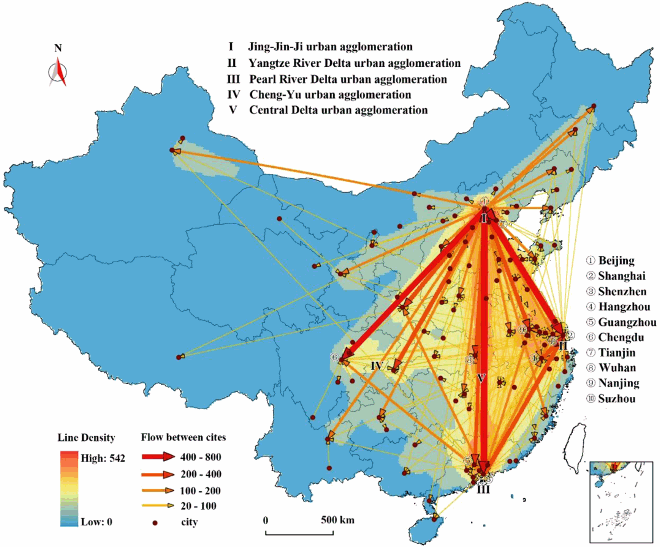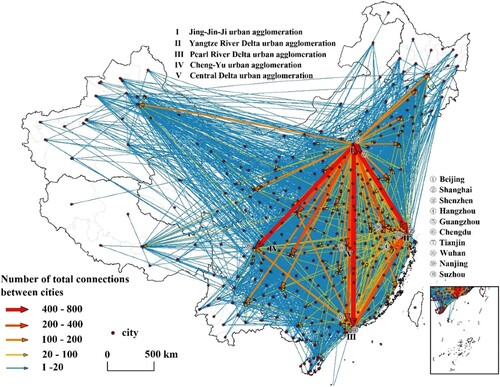ABSTRACT
As important actors in innovation, global innovative enterprises have shaped the innovative pattern of the world. China’s most innovative enterprises have also transformed the innovative landscape in China. Using the location information of the 1778 most innovative enterprises in China and the headquarter–branch method, we visualized the Chinese urban network constructed by these enterprises. Although the network covers 353 cities across China, its spatial distribution is extremely uneven. A few cities dominate the structure of the network, and Beijing stands in a strong control position. Megacities and provincial capitals have become the favoured headquarter locations of innovative enterprises. The five major urban agglomerations form the uneven diamond structure in the innovation network.
JEL CLASSIFICATIONS:
Enterprises play a vital role in innovation and technological innovation, especially in the knowledge economy era. However, existing research mainly focuses on the promotion of cluster innovation of small and middle-sized enterprises through their network connection at different scales (Bathelt et al., Citation2004; Morrison et al., Citation2013), but there is little discussion about the contributions of large innovative enterprises. In fact, large innovative companies such as Apple, Google and AT&T have dominated the major application technology innovations around the world. On the one hand, they establish the cooperative research and development (R&D) network to attract innovative talents and resources from all over the world and improve the innovation capacity of enterprises; and, on the other, they establish branch factories and extensive marketing departments to promote technology communication and application as well as brand publicity. They have shaped the global innovation landscape by establishing numerous branches around the world (Florida & Kenney, Citation1994). Large innovative enterprises in China have also set up their own branches at home, even around the world, to improve innovation capacity and technological efficiency. Of course, large innovative enterprises in China are more likely to set up branches at home, which exerts great influence in constructing the technological innovation pattern of China.
We selected 1778 large-scale innovative enterprises with multi-sectors distributed in different cities based on the evaluation of Chinese innovative enterprises by various authoritative institutions and collected their headquarters and branches (a total of 41,197) as well as location information in 2018. Due to the confidential nature of technology diffusion and cooperation between headquarters and branches of large innovative enterprises, the headquarter–branch model is adopted to establish the relationship between the cities where the headquarters are located and the cities where the branches are located. Considering the different degrees of connection between headquarters and various branches, four strength levels were used for differential assignment.Footnote1 Based on this, the directional relation strength between cities established by these innovative enterprises could be calculated, which is called intercity innovation enterprise linkages (IIEL).
As shown in , the network links 353 cities in China and covers almost all prefecture-level administrative regions in China, showing significant spatial imbalance and regional heterogeneity.
First, a few cities dominate the main structure of the network. Beijing, the capital of China, has strong control over the network. A total of 245 innovative enterprises whose headquarters are in Beijing have set up branches in 297 cities outside Beijing, sending out 9926 IIEL (22.78% of the total), which is far higher than the second city, Shenzhen (sending out 3423 IIEL), and the third city, Shanghai (sending out 2778 IIEL). In addition, Beijing also has a strong attraction, absorbing 1502 branches of enterprises from other cities (absorbing 3788 IIEL), which is higher than the second city, Shanghai (absorbing 3493 IIEL), and the third city, Shenzhen (absorbing 1901 IIEL). The top 10 cities of the total number of IIEL account for 47.27% of the total.
Second, the directional relationship between cities differs widely, and there is obvious connection preference. The number of places with large numbers of connections (at the 400–800 level) is small, most of which occur between important regional central cities. This is expected, as the headquarters and branches are mostly located in those cities. Specifically, when choosing cities to set up branches, innovative enterprises prefer megalopolises such as Beijing and Shanghai, and many provincial capitals also have become the second-level diffusion sources and concentration centres of innovative enterprises. Statistics show that 33.18% of the cities set up the most branches in the provincial capitals, and 42.21% of the cities receive the most branches from the provincial capitals.
Third, the five major urban agglomerations have supported the overall pattern of the network. Urban agglomerations are supposed to be the incubators for innovation (Ma et al., Citation2018). China’s five national-level urban agglomerations and the connection lines between their inner cities constitute an asymmetrical rhombohedral structure. It is also found that the three coastal urban agglomerations play a more prominent role, aggregating 56% of the headquarters and 50% of the branches of innovative enterprises. Under the influence of Beijing, the Jing–Jin–Ji urban agglomeration (JJJ) has a very prominent external connection. However, the inner connection of the Yangtze River Delta urban agglomeration is closer than JJJ and the Pearl River Delta urban agglomeration. The Central delta agglomeration in central China did not play a good role in connecting north with south and linking east and west. The lack of connection between the Cheng–Yu urban agglomeration and other urban agglomerations, except for the JJJ in western China, makes the diamond pattern slightly broken.

DISCLOSURE STATEMENT
No potential conflict of interest was reported by the authors.
Additional information
Funding
Notes
1 The links between the headquarters and the R&D centre are assigned a value of 4; the links between the headquarters and the regional headquarters take a value of 3; the links between the headquarters and the production plants take a value of 2; and the links between the headquarters and the subordinate offices take a value of 1.
REFERENCES
- Bathelt, H., Malmberg, A., & Maskell, P. (2004). Clusters and knowledge: Local buzz, global pipelines and the process of knowledge creation. Progress in Human Geography, 28(1), 31–56. https://doi.org/10.1191/0309132504ph469oa
- Florida, R., & Kenney, M. (1994). The globalization of Japanese R&D: The economic geography of Japanese R&D investment in the United States. Economic Geography, 70(4), 344–369. https://doi.org/10.2307/143728
- Gui, Q. C., Liu, C. L., Du, D. B., & Duan, D. Z. (2019). The changing geography of global science. Environment and Planning A: Economy and Space, 51(8), 1615–1617. https://doi.org/10.1177/0308518X18816694
- Ma, H. T., Fang, C. L., Lin, S. N., Huang, X. D., & Xu, C. D. (2018). Hierarchy, clusters, and spatial differences in Chinese inter-city networks constructed by scientific collaborators. Journal of Geographical Sciences, 28, 1793–1809.
- Morrison, A., Rabellotti, R., & Zirulia, L. (2013). When do global pipelines enhance the diffusion of knowledge in clusters? Economic Geography, 89(1), 77–96. https://doi.org/10.1111/j.1944-8287.2012.01167.x

